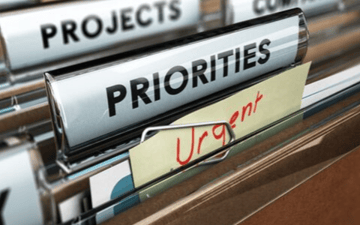As a Maintenance Planner or Maintenance Scheduler, do you sometimes feel like there are more fires to put out than you have time for? Hopefully, all those fires are metaphorical.
Staying on top of emergencies and reactive work while still prioritizing planned, preventive maintenance is no walk in the park. But constant firefighting means that routine, less urgent, or preventive tasks often get pushed to the work scheduling backburner. And they don’t just sit there. They multiply (or seem to).
If you’re nodding your head as you read this, you’ve got it bad. You’ve got backlog.
A common misconception is that asset management backlog consists only of work not completed by its deadline or due date. But it’s a bit broader than that. Backlog is a build-up of work waiting to be completed.
Not all work is created equal, however, and the build-up may be comprised of any combination of asset maintenance work that is resourced and in progress, scheduled for a date in the future, as well as planned or unplanned work.
6 steps to beat your enterprise maintenance backlog
Backlog is a resource capacity scheduling challenge, but it’s important to start thinking of it in terms of priorities and Asset Criticality rankings rather than deadlines. By thinking in these terms instead of due dates, you avoid being stuck in a cycle of continually setting deadlines and not meeting them, or allowing critical, urgent maintenance work to go unnoticed for too long.
Whether your backlog beast is a rampaging, out-of-control behemoth with thousands of work orders or a somewhat tamable critter with just a few line items, one thing is clear: you need to identify asset criticality, prioritize, and create a plan of action.
Here’s how to get started:
1. Assess your work scheduling backlog.
Your backlog is likely messy, confusing, and daunting. Save your future self precious time by committing to sift through it now. All kinds of things can sneak into this pile, so keep an eye out for:
- Duplicate work
- Completed work
- Work that needs modifications (e.g. tasks that need to be re-evaluated and approved)
The easiest way to spot duplicate work is by location and/or asset number. Completed work can be a little trickier to weed out. Search for it by the dedicated crafts or labor assigned to the work. Address any modifications by priority – safety being the highest priority of all.
2. Organize your maintenance work orders.
Figure out the who, how and what of each of your work orders. For each one, you need:
- A description of the work to be performed and adequate tasks and hours on the Job Plan
- A list of the required resources (skills, crew size, man hours/shift scheduling, parts/materials, special tools/equipment, permits, reference documents, etc.)
- A cost estimate
- A pre-brief or outline of safety tasks/procedures included in the Job Plan
- A list of the involved parties and how they will communicate
3. Get the Maintenance and Operations teams together.
To tackle backlog effectively, all groups and operations involved need to be on the same page.
As a team, review all the jobs that need to be completed and establish a sequence in terms of priority and asset criticality.
Evaluate each task and consider the importance of its completion, how critical the equipment is to operations, and consider the impact of equipment downtime or failure.
Most companies use a simple matrix chart to identify pools of like priorities.
So, for example, an asset criticality of 1 paired with a priority 1 is likely the work most important to be scheduled first.
In today’s world, it’s likely the Asset Owner who will have the final word on what priority work should take place. Asset owner roles should never conflict with one another, and will usually be based on output or production schedules based on reliability.
4. Create a workforce scheduling plan of attack.
You’re finally here!
Scheduling needs to consider the information you gathered in Step 3. Set a time for a task to be completed, making sure you consider the availability of labor, resources and equipment.
This is where you’ll want to make sure you have the right Planning and Scheduling tools for your CMMS, to get things done efficiently. The last thing you want is for building the schedule to take longer than it has to, or to be needlessly complicated.
Ideally, you’ll have one-click scheduling and assigning features that you can use to schedule and assign many work orders at once, so that you can build your maintenance schedule in less time.
5. Monitor your maintenance scheduling actuals.
Are things going as planned? Because the landscape is constantly changing, your schedule needs flexibility. This is especially true if you do not have preventive measures in effect (more on this later!). You, or another member of the Maintenance Planning and Scheduling team, such as the Scheduling Manager, should report on this at the weekly Planning and Scheduling meeting.
6. Reflect, revise and optimize your MRO.
When you’re time poor, it can be tempting to skip this one. But investing time in reflection will save you time down the road. After all, what’s the point of doing anything if you’re not going to evaluate what worked, what didn’t, and what could be done better in the future?
Look at your maintenance planning and scheduling.
- What was missing?
- What was off the mark?
- Was the appropriate technician assigned?
- What did you forget to include?
Analyze your scheduling.
- How many tasks were completed on schedule?
- How many had to be rescheduled?
- Look for patterns.
Inspect your backlog. A general best practice is to have no more than approximately two weeks of backlog per technician. If you are consistently operating above or below that average time, you may be over- or under-staffed.
It’s important to note that ideal backlog size really depends on how the maintenance staff is made up and how work is assigned – the ideal size may be different for your organization.
Look for backlog trends, as well. Is the backlog building up in a certain area? How much of your backlog is critical in terms of safety? Is preventative maintenance routinely being put off?
3 tips to keep your maintenance backlog under control
You have tackled your backlog problem. Your maintenance planning and scheduling efforts are effectively managing work identification and execution in a reliable and cost-effective manner. Now, you need to put MRO systems in place so that you don’t end up there again. Take these proactive tips to banish the likelihood of future backlog issues:
1. Make your maintenance planning and scheduling meetings count.
Ultimately, you need to decide what is reasonable and realistic for your organization, but don’t hesitate to be ambitious.
Daily scheduling meetings bust through backlog. Not only that, meetings need a structured agenda and should be no longer than a half hour. Make sure the meeting is focused solely on scheduling, too. This is not the time for planning.
2. Manage priorities.
There will always be those big, critical jobs that need to be completed urgently. Make sure not to forget about the lower priority jobs though. Low-priority tasks are in danger of being put off endlessly.
The solution? Keep an eye on those less pressing jobs. Give them increasing priority as you move forward.
3. With enterprise maintenance, remember that forewarned is forearmed.
And that brings us to well-planned preventive maintenance plans (PMs). You may not feel that you have time for PMs in your schedule, but make time. Integrating proactive repair procedures into your scheduling is the single most effective way to maximize ‘tool time.’ Plus, PM helps to drastically reduce failure and downtime risk. So those fires you’re tired of fighting? They can fade into the past.
It takes time, effort, and diligence to tame the backlog beast and become a Planning and Scheduling hero. But if you can get your backlog under control, ensure that your maintenance Planning and Scheduling is consistent, organized, and well-communicated in structured meetings, you’ll be on your way to sustainable, continuous Planning and Scheduling process improvement.
Looking for more of these valuable planning and scheduling tips? Download our free, detailed white paper on maintenance planning and scheduling best practices.



